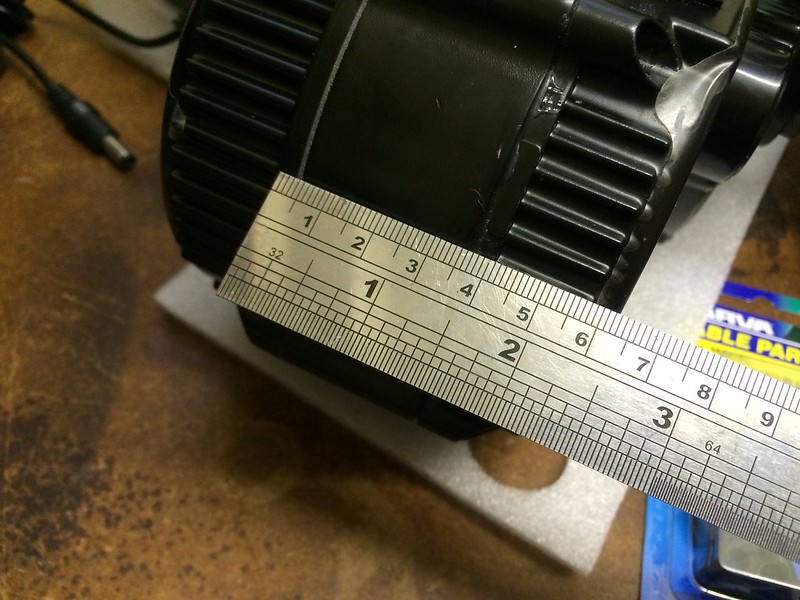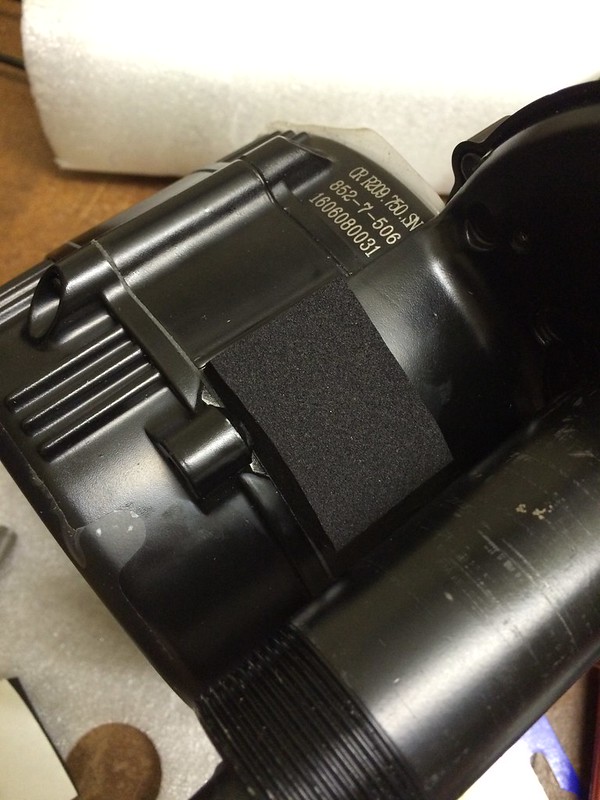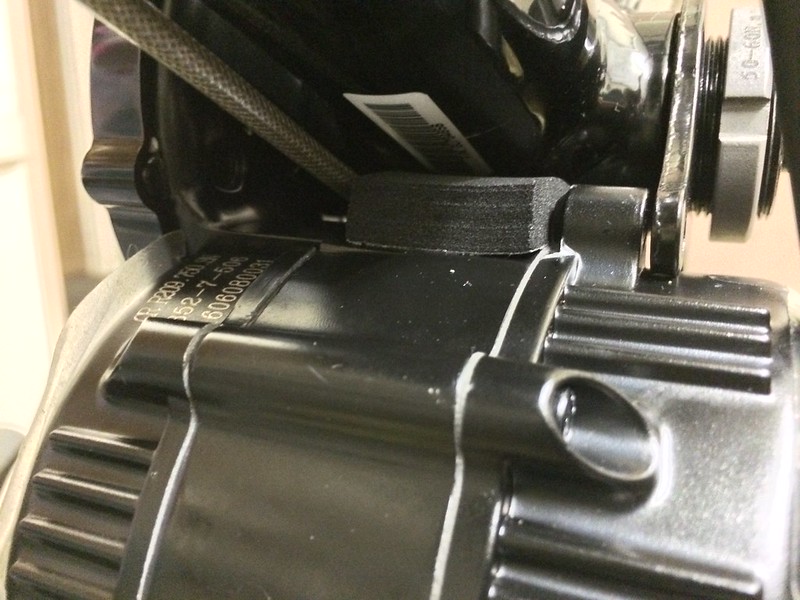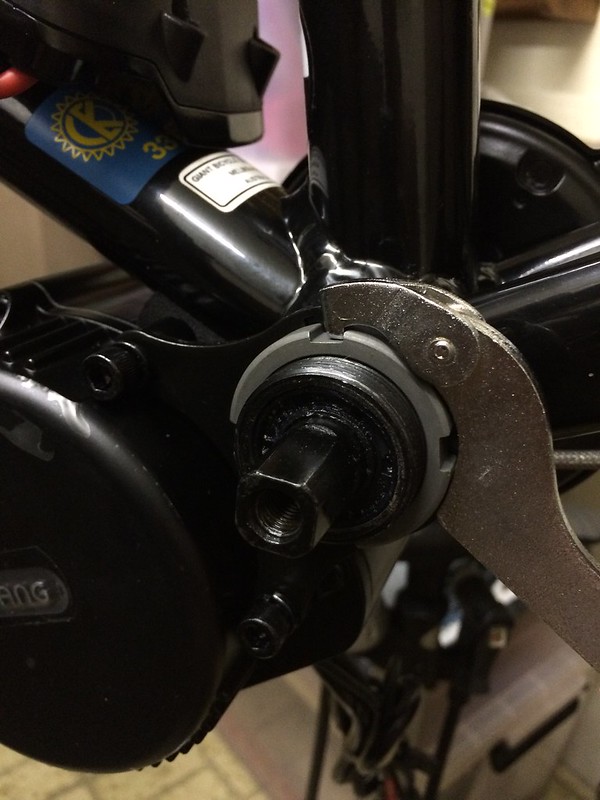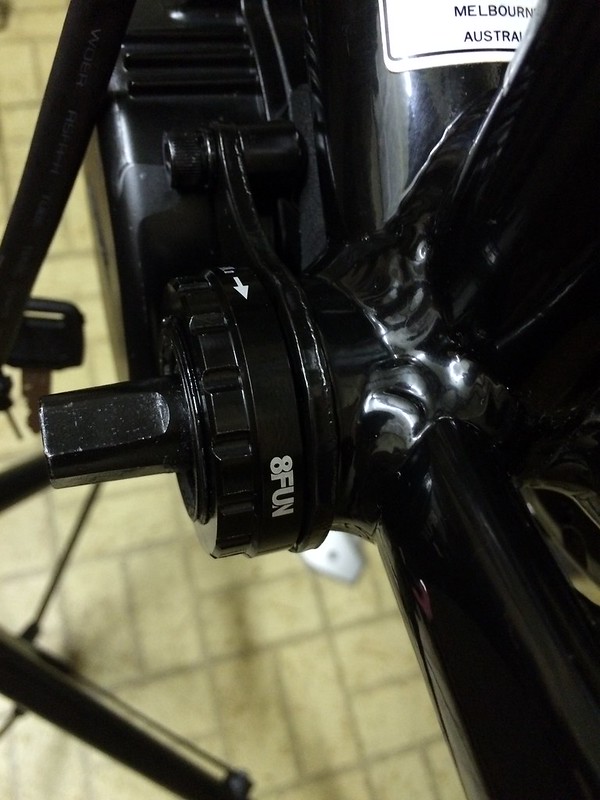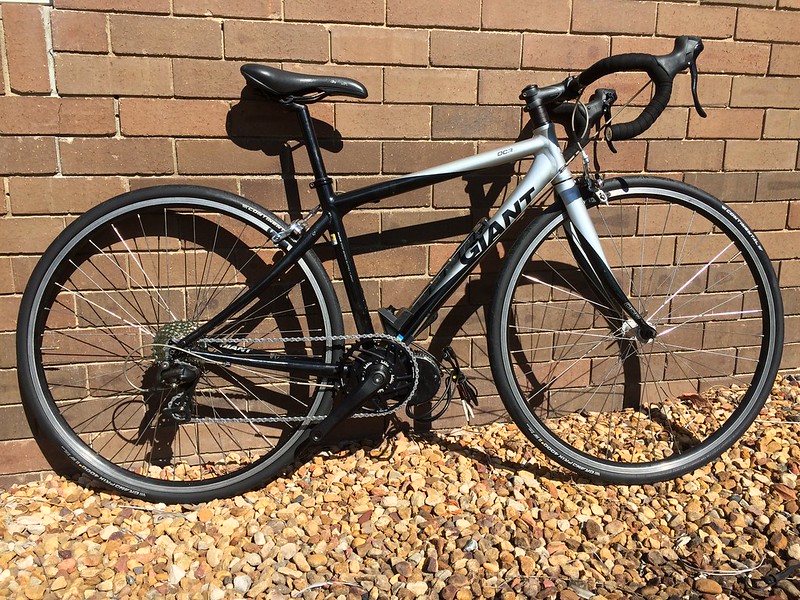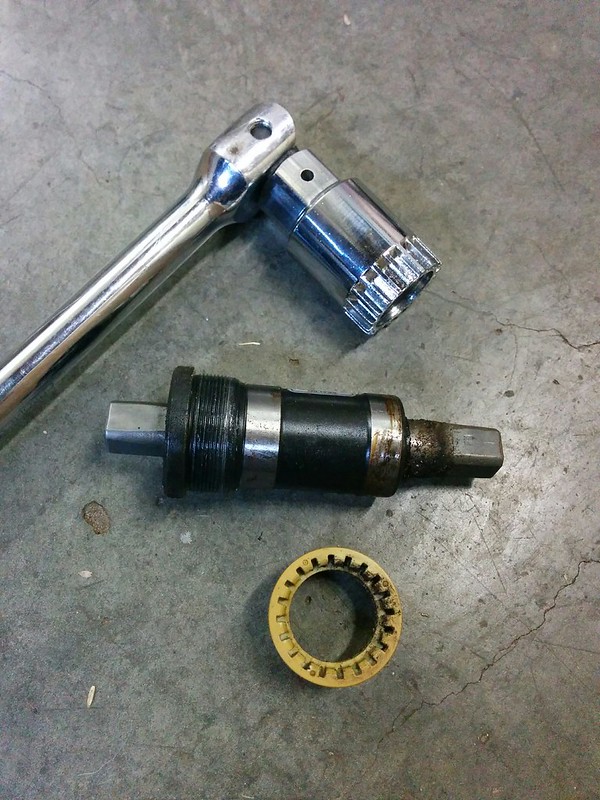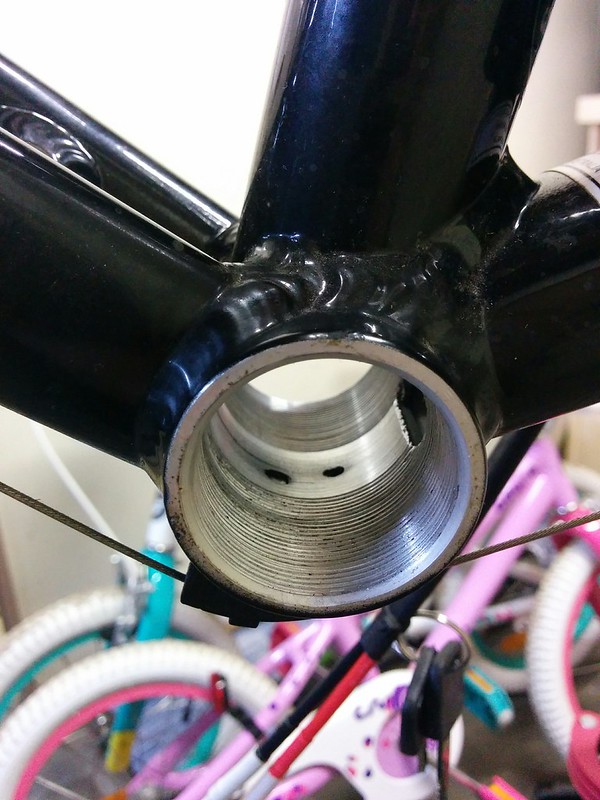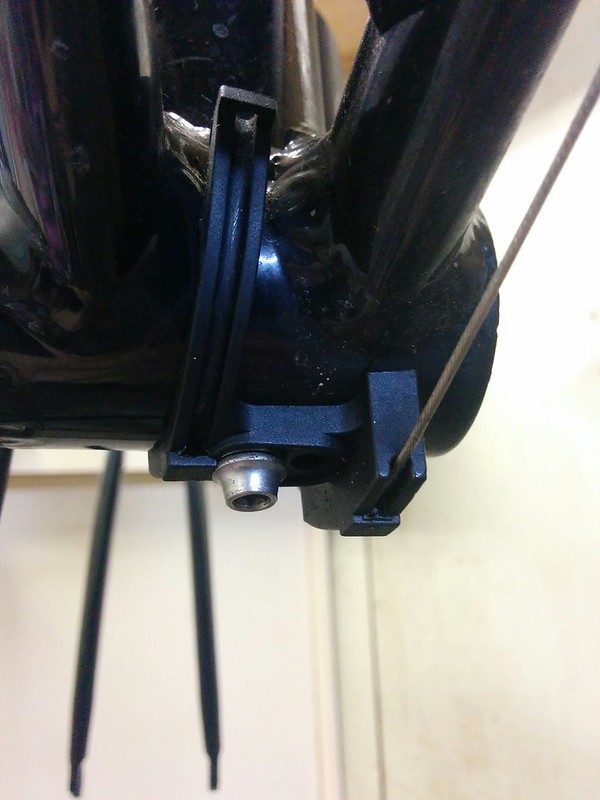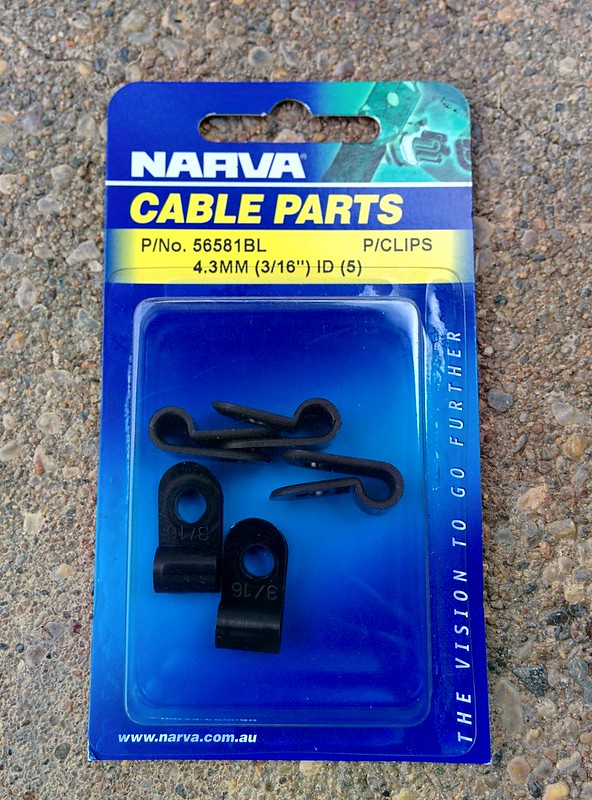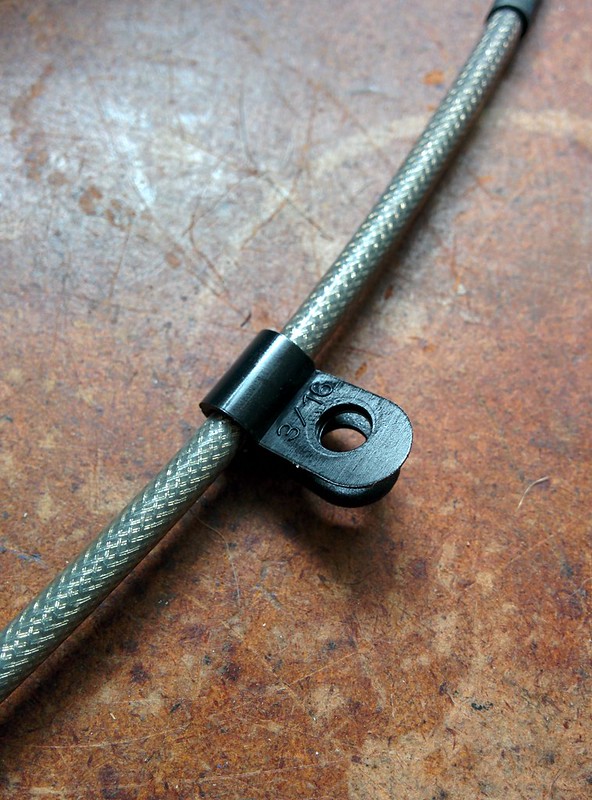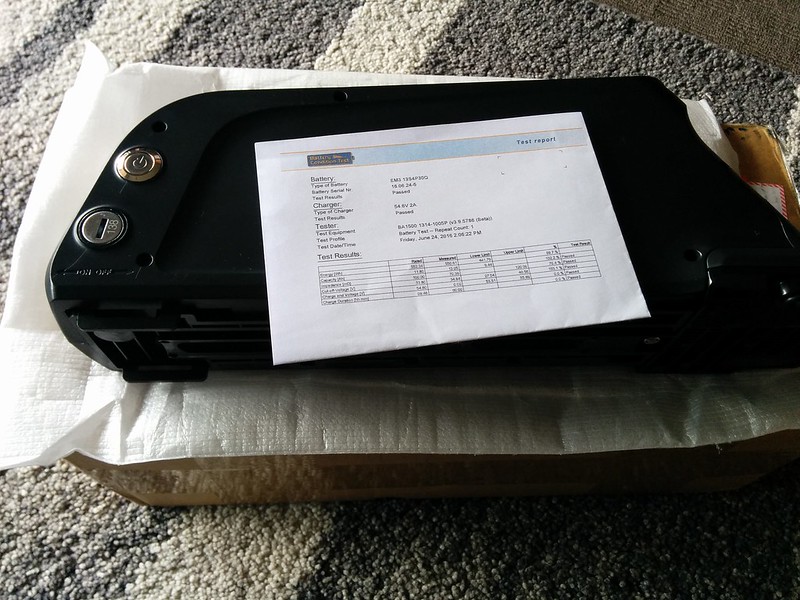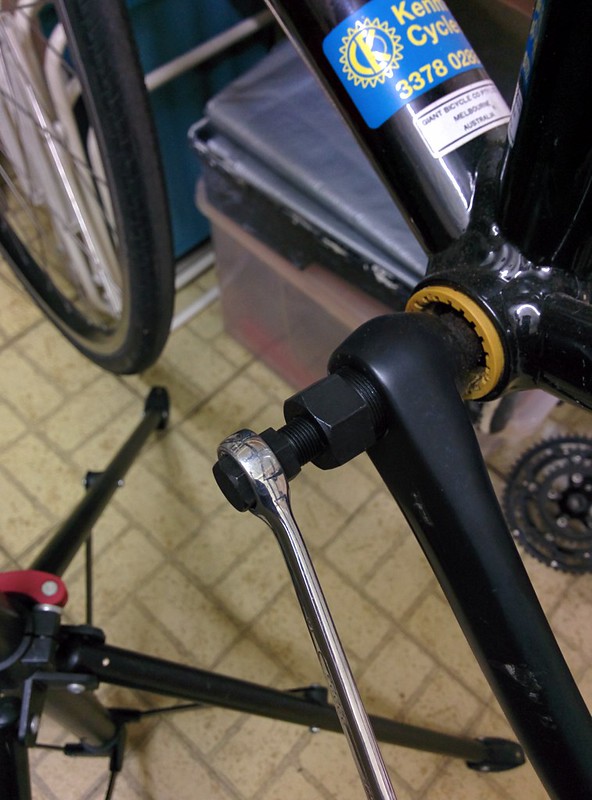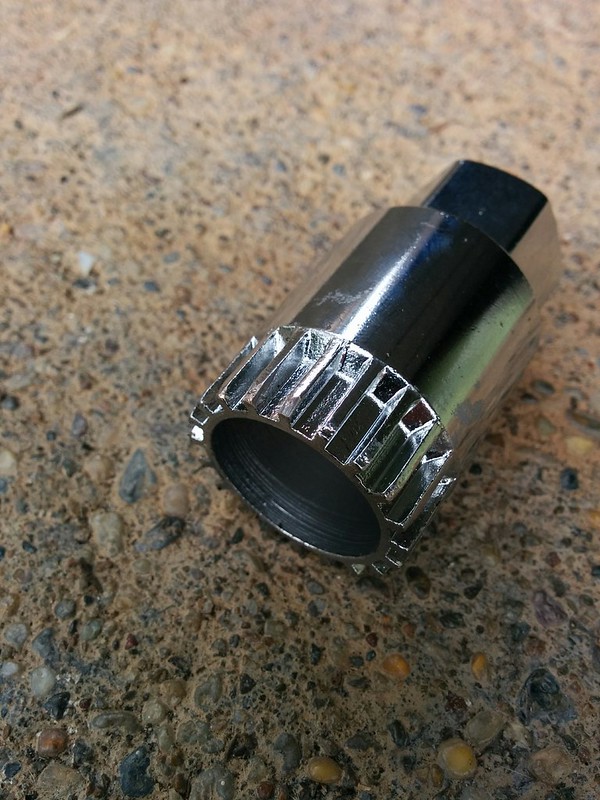Continued from Electric bike build part 2.
I now had all the parts and tools available to fit the motor to the BB shell. I had read that the high torque from the motor could dent alloy frames so I picked up some Neoprene rubber to try and reduce the chance of this happening:
Rubber applied:
Test fit, the final fit will have the rubber fully compressed between the motor and frame:
Looks good!
One slight issue I had was the hole on this steel bracket being drilled slightly offset, meaning the fastener wasn't able to be fitted without binding. I drilled the hole 0.5mm larger then nail polished the exposed metal:
Thanks yet again to my Aldi bike toolkit I had the right tool on hand. I was able to (blue) Loctite then tighten at the same time as holding the motor against the frame fully compressing the rubber:
All done:
I then applied Loctite to the two additional bolts and the extra lockring (you can use a standard Shimano Hollowtech II tool) then fitted:
Here's a pic after I fitted both crankarms and chain:
It's starting to come together!
Continued at Electric bike build part 4.
Saturday, 23 July 2016
Monday, 18 July 2016
Electric bike build part 2
Continued from Electric bike build part 1.
The tool now worked fine to remove the bottom bracket:
The shell looks really clean already:
Here's the next snag, the bracket for the shifter cables gets in the way of the BBS02:
After a bit of thinking, I came up with the idea of using some cable outer tube and a cable clamp. Here are the clamps I bought:
Looks promising:
Bolts up fine:
Yes! It worked:
Time will tell if this is a reliable solution, but it looks pretty good to me. I'll probably zip tie the cable outer to the frame at each side with a gentle radius.
Continued at Electric bike build part 3.
The tool now worked fine to remove the bottom bracket:
The shell looks really clean already:
Here's the next snag, the bracket for the shifter cables gets in the way of the BBS02:
After a bit of thinking, I came up with the idea of using some cable outer tube and a cable clamp. Here are the clamps I bought:
Looks promising:
Bolts up fine:
Yes! It worked:
Time will tell if this is a reliable solution, but it looks pretty good to me. I'll probably zip tie the cable outer to the frame at each side with a gentle radius.
Continued at Electric bike build part 3.
Electric bike build part 1
I have been collecting the bits to put together my first electric bike. It's still a work in progress so this will be my build diary. The objective is a reliable and quick road/bikeway commuter to make biking to work a more attractive option!
My first purchase was a used 2008 Giant OCR complete with weathered chain and perishing tyres:
At first I thought the rims were worn but it is just some surface corrosion, the bike has barely done any mileage. Importantly the frame, brakes, wheels and RD/shifters are all working well. I pretended the bike was a CX bike and took it on some trails near my house to test everything was working as intended, it all seems quite solid. The standard RD-2200 rear derailleur even worked smoothly with a 11-32 cassette!
The next step was to make a cardboard template to ensure the battery pack I intended to buy would fit, a shame both drink holders are no longer usable but looks good otherwise:
I also checked the distance between the BB shell and the outside of the frame (quite small, so no problems here), and the type of BB shell (68mm English). Everything checks out, time to pull that trigger on the order!
I bought the BBS02 from Paul and his team at EM3EV, my only comment is they had a shipping issue with the battery using TNT but everything was sorted out quickly by them using an alternate carrier at no cost to me. Big thumbs up for service from EM3EV, and their workmanship on the crimping/heatshrink looks great. Here are the fun bits:
Armed with my $20 Aldi bike toolkit, I started stripping down the bike and removing the crank, the tools held up fine for this step:
Unfortunately when I went to remove the bottom bracket cup I found the tolerances on the tool weren't good enough and some splines were too fat:
Fortunately I was able to tidy these up with an angle grinder:
I have done a test fit of the tool and it engages fine now, but I haven't gotten any further. I'll try to document the rest of the build as I go. I hope you find this build as interesting as I do!
Continued at Electric bike build part 2.
My first purchase was a used 2008 Giant OCR complete with weathered chain and perishing tyres:
At first I thought the rims were worn but it is just some surface corrosion, the bike has barely done any mileage. Importantly the frame, brakes, wheels and RD/shifters are all working well. I pretended the bike was a CX bike and took it on some trails near my house to test everything was working as intended, it all seems quite solid. The standard RD-2200 rear derailleur even worked smoothly with a 11-32 cassette!
The next step was to make a cardboard template to ensure the battery pack I intended to buy would fit, a shame both drink holders are no longer usable but looks good otherwise:
I also checked the distance between the BB shell and the outside of the frame (quite small, so no problems here), and the type of BB shell (68mm English). Everything checks out, time to pull that trigger on the order!
I bought the BBS02 from Paul and his team at EM3EV, my only comment is they had a shipping issue with the battery using TNT but everything was sorted out quickly by them using an alternate carrier at no cost to me. Big thumbs up for service from EM3EV, and their workmanship on the crimping/heatshrink looks great. Here are the fun bits:
Armed with my $20 Aldi bike toolkit, I started stripping down the bike and removing the crank, the tools held up fine for this step:
Unfortunately when I went to remove the bottom bracket cup I found the tolerances on the tool weren't good enough and some splines were too fat:
Fortunately I was able to tidy these up with an angle grinder:
I have done a test fit of the tool and it engages fine now, but I haven't gotten any further. I'll try to document the rest of the build as I go. I hope you find this build as interesting as I do!
Continued at Electric bike build part 2.
Wednesday, 17 February 2016
Aldi 3D printer
I picked up an Aldi "Cocoon Create" 3D printer this morning and spent a bit of time trying it out. It appears to be a rebranded Wanhao I3:
The unit was packed really well and included a few goodies including a really comprehensive printed manual:
Putting the unit together was really simple, here's the unit after following the quick start guide:
It's using Jinsanshi Motor stepper motors, they seem to be fairly quiet:
The earth pin is connected:
Here's a photo I took during bed levelling:
This cord was pinching a bit, so I pulled it upward to resolve the issue:
First print:
All done:
Improving the machine already:
I'm really quite impressed with this machine especially given the price point. I was up and away printing a job within 15 minutes of opening the box.
The only thing I can whine about is the power supply fan which is unnecessarily loud. You certainly wouldn't want to have the thing running all day in the same room in an office environment.
The unit was packed really well and included a few goodies including a really comprehensive printed manual:
Putting the unit together was really simple, here's the unit after following the quick start guide:
The earth pin is connected:
Here's a photo I took during bed levelling:
This cord was pinching a bit, so I pulled it upward to resolve the issue:
First print:
All done:
Improving the machine already:
I'm really quite impressed with this machine especially given the price point. I was up and away printing a job within 15 minutes of opening the box.
The only thing I can whine about is the power supply fan which is unnecessarily loud. You certainly wouldn't want to have the thing running all day in the same room in an office environment.
Saturday, 30 January 2016
First play with the BitScope Micro
I picked up a BitScope Micro to teach myself a bit about oscilloscopes. So far I've only used the first analog channel to monitor the wave generator, but it seems to do what it says on the box:
The test leads aren't the best quality, but otherwise this looks like a useful tool. You can't expect it to be in the same league as the professional gear, but for the money it's great for learning.
The test leads aren't the best quality, but otherwise this looks like a useful tool. You can't expect it to be in the same league as the professional gear, but for the money it's great for learning.
Saturday, 23 January 2016
Modifying the (Aldi) Lumina coffee grinder to produce a finer grind
As this machine uses burrs to do the grinding I thought I'd try shimming one of the burrs to bring the two closer together, hopefully resulting in a finer grind. This actually ended up working really well, and I've been using it at least three times a week for a few months now for all my coffee grinding duties!
Here's what you will need to do the modification:
- Useless Lumina coffee grinder.
- Suitably sized Phillips head driver (you'll want to make sure it is clean).
- Three 8x1mm washers (again, make sure they are clean).
First of all you'll want to remove the top burr assembly, which you can do by turning it clockwise:
You can see the tabs that lock it into place here:
Once you've removed it, flip it upside down and you should be able to see three Phillips head screws, you'll want to remove these:
Lift the metal burr away from the rest of the plastic assembly and you will then be able to fit the three 8x1mm washers as per the picture:
As you can see this has shimmed the burr by 1mm:
Fit the burr back onto the assembly and fasten the screws, don't go overboard with force though as they are just screwing into plastic.
Adjust the machine to the coarse setting and insert the top burr assembly, lock it into place by turning anti-clockwise.
Test out some grinding!
Fluke 17B+ multimeter review
This is just a quick and honest review of my Fluke 17B+ multimeter.
Pros:
Cons:
The included TL75 test leads seem sufficient and seem to be of a reasonable quality.
As a hobbyist, this multimeter should serve me well. If you need more precision or you do AC measurements you might want to consider something like the Brymen BM257S.
I had assumed the 17B+ would have featured auto hold, so I was a bit disappointed about that (in fact it probably would have swayed me toward the BM257S) but I'm certainly not disappointed in the overall product.
- Excellent build quality and decent/safe input protection.
- Nice large screen with good backlight.
- Continuity tester seems fairly fast and the latching works well.
- Has a diode tester, frequency, thermistor input and can measure in the microamp range.
Cons:
- Hold function is not Fluke's auto hold (as you would get on the 87V), it simply freezes the current display.
- Only 4000 count with 0.5% +3 accuracy (DC volts).
- Not a true RMS meter.
The included TL75 test leads seem sufficient and seem to be of a reasonable quality.
As a hobbyist, this multimeter should serve me well. If you need more precision or you do AC measurements you might want to consider something like the Brymen BM257S.
I had assumed the 17B+ would have featured auto hold, so I was a bit disappointed about that (in fact it probably would have swayed me toward the BM257S) but I'm certainly not disappointed in the overall product.
Subscribe to:
Posts (Atom)
